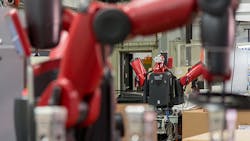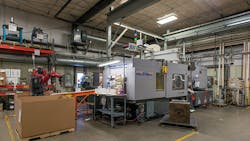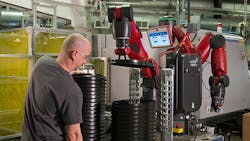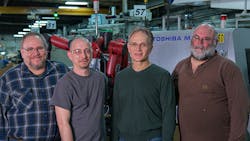How One Minnesota Manufacturer Overhauled Its Floor with Robots
What’s red, stands 6-foot-3 when on a pedestal, has two arms and a big smile, and can work 24/7 without ever taking breaks for coffee or the bathroom?
Baxter, the collaborative robot, of course.
Baxter loves to load, unload, sort, count and handle parts. He has a brother named Sawyer, and both were created to take over boring repetitive jobs, freeing up we humanoids for more complex tasks. But their real skills lie in the fact that they have been able to increase speed, precision and accuracy for companies like Donnelly Custom Manufacturing in Alexandria, Minnesota.
Baxter’s and Sawyer’s producer, Boston’s Rethink Robotics, was founded in 2008 by MIT roboticist Rodney Brooks, co-founder of iRobot. Since 2013, when the first collaborative robot was released, Rethink Robotics has placed about two dozen units in Minnesota, where Donnelly is headquartered. Priced at about $25,000 each (about $35,000 equipped for deployment at Donnelly), Baxter stands 3-foot-1 without his pedestal and weighs in at 165 pounds. His maximum reach is 47.6 inches, and his maximum payload is 5 pounds.
A fixed Baxter robot removes parts from press and places on conveyor where a Baxter robot is stationed at end of conveyor to bulk pack and count parts placed in large Gaylord box for shipment to customer.
“We were the first to get Baxter deployed on the shop floor in Minnesota, and we knew we were in good company on the whole automation continuum,” Donnelly president Ron Kirscht said. “We were starting to immerse ourselves in the collaborative robot journey.”
Donnelly employs 220 human employees, focusing on injection molding, with 2,000 discrete parts made from 1,800 different active molds. Active in short-run manufacturing, Donnelly wanted Baxter to increase their speed, precision and accuracy for their leading industrial original equipment manufacturer customers.
“At Donnelly, we have continuous application of automation to do contract injection molding for industrial OEMs,” Kirscht said. The company holds no patents — all are held by customers. Donnelly buys plastic raw material from large raw material multi-national chemical companies and distributors.
“We are the mosquito that dances with elephants,” Kirscht said. “We’ve got to be quick or we get smashed.” The operation focuses on short runs with an average of 13 hours; median runtime is less than seven hours, which means that Donnelly operators must be really good at changeovers, start-ups, and processing.
Tool and Parts Design
The company likes to build close customer working relationships. For 2,000 active parts, Donnelly manages the customer’s production order project from start to finish, although they do not build molds. Kirscht lays out the order flow: “Customers come up with requests, we help with the design of parts and tooling to meet design requirements for fit, function and manufacturability. After the customer has issued a PO to build the tools, we outsource it to approved toolmakers. Although close to half the molds are built overseas, we take full responsibility for the build of a mold: We’ll get it built, sampled, inspected and approved.”
The Alexandria site runs 35 injection molding machines, ranging in size from 20 tons to 720 tons clamping force — the larger the part, the larger the mold, the larger the machine. Products include components for paint sprayers, fluid and air filtration products, large industrial grade ice machines, ATMs, diaphragm pumps for industrial applications, sensors and industrial automation control, linear drives, security card machines and medical equipment. “We avoid automotive,” he said.
Donnelly’s First Robotic Initiative
Jerry Bienias, Donnelly’s VP of Operations and a 23-year veteran, recalls their first work with robots. “When we started to use robotics, we began with top-of-press robots. The robot would basically sit on the press, remove a part, and set it on a conveyor.” Ten years ago this would have been a typical robot application, but Donnelly realized that approach did not quite fit their business model. “The problem we had 10 years ago is that we knew we were only going to run this particular mold for eight to 20 hours. And it doesn’t pay to have individual end-of-arm tooling for each job.” So when Donnelly encountered its first robotic challenge, they developed a universal end of arm tooling as a response. “We now have five different standard styles on 80 to 90% of tooling. Before, we had one robot on a press that seldom got used, but now every press over 155 tons has a part removal robot.”
That one success was enough, Bienias said, to persuade Donnelly and its Manufacturing Steering Committee to go further with robotics. “The value of a robot in manufacturing is that you get consistency in cycle time, which supports defect-free molding. So many parts have cosmetic requirements, and having that part removal come in perfect every time, with consistent cycle time, really makes a difference. Once we solved that dilemma, we were getting parts removed and going down the conveyor in a very predictable flow.”
Rethink Robotics
One of Donnelly’s 220 human employees removes a completed set of parts for final packaging while Baxter begins loading molded parts on the next prepackaging and counting fixture available.
By 2014, the Manufacturing Steering Committee started looking at collaborative robots, thinking through how Donnelly could use them to take parts coming down the conveyor and perform more tasks with them. “We wanted to remove some more labor,” Bienias said. “Presses are tied into process monitoring, so if anything is wrong with process, the conveyor will divert parts. And Baxter will receive only good parts to put in a box.”
The net result for Donnelly is that quality remains at 99.8%, with increased productivity, freeing up people for more varied and interesting tasks. Management has tracked the first Baxter’s performance starting in January 2015, followed by the second in March 2015. “We formed a team to learn how to make Baxter effective and adaptable to Donnelly’s short run model,” Kirscht said. Planning in advance of deployment took time but it made sense in the long run. “We spent a lot of time up front to evaluate and make Baxter very flexible, with a servicing platter hanging off the front outfitted with and all parts and tools needed for Baxter’s intended roles and assignments on the shop floor.”
Early on, the Donnelly team recognized Baxter’s potential to bring manufacturing capabilities to a higher level and the ability to mistake-proof production was very attractive. “These are perfect applications for Baxter. He’s flawless and happily engaged. Plus, anybody with a little bit of training can program Baxter; in 2014, when we went down to look at Baxter in person at Minneapolis Automation before buying, we discovered it took five to 10 minutes to program Baxter for a new task.”
What is Baxter’s learning style, if not Basic Assembly Language? His friends say he is basically a hands-on kinesthetic learner. The Donnelly deployment team was made up of a maintenance person, two setup people and two manufacturing support people to begin the process of understanding and successfully deploying Baxter. Within two weeks, the team and Baxter were tackling the first parts Baxter was tasked with working on.
Rethink Robotics
Part of the Donnelly Custom Manufacturing team, including industrial technologist Chad Rhen, second from right, on the floor.
The team started Baxter off with bulk packing parts when picking and counting accurately were very involved and important. Baxter caught on fast, starting with 600 parts bulk packed in one big container, a task that took humans too long to finish, even when broken into lots of 50. “Now, Baxter stands at one end and places 600 parts into the next box — one on his left and one on this right — he never gets distracted or takes a coffee break!”
Soon, the Donnelly team wanted to expand Baxter’s repertoire of applied capabilities into layer packing parts. The first job involved nine parts layer capped by a divider between each layer. Now the co-bot has 15 discrete parts on his resume of parts he can layer pack. As the parts come down a conveyor, Baxter inserts a fixture and packs the unit. Donnelly’s production rate totaled 25,000 per year on the first part alone.
Looking back, the Donnelly team realized how quickly Baxter could pick up and execute a formerly human task. “A lot of times, Baxter has been on the sidelines,” Bienias said. “We’ve really had to think creatively about how to further expand what Baxter does. It took just a little over a year to deeply integrate Baxter on the floor. But it’s been a productive year and our confidence is growing as we find new ways to use Baxter to help us to deliver good parts on time.”
Kirscht sees this robotic work as exciting and filled with potential. “People are redefining the human role, exactly what manufacturers have to do,” he said. “People in production areas are challenged in ways that require more skills and that elevate what they are asked to do. I believe if you can align people with automation — make the work interesting, varied, challenging — you will have changed the nature of work for the better.”
“Were we taking a big risk?” Bienias said. “Think about the Wright Brothers and Neil Armstrong. They took tremendous risks. But we are not pioneers, we are settlers, so we were pretty confident we would figure out ways to do it.”
About the Author
Patricia Moody
Publisher
Patricia E. Moody is a writer and manufacturing and supply management consultant with over 30 years of management consulting, hundreds of articles and interviews, speeches, and 12 books to her credit. She is the publisher of Blue Heron Journal, an online resource for thought-leaders and decision makers.
Named by FORTUNE magazine one of the "Ten Pioneering Women in Manufacturing," she was featured on CNN's "21ST CENTURY WITH BERNARD SHAW." Her consulting client list includes Motorola, Respironics, British Petroleum, Waste Management, and Cisco. She consulted to Johnson & Johnson's McNeil Consumer Labs during the Tylenol poisoning crisis and is credited with saving the company. She has an MBA and an Honorary Doctorate.
A pragmatic visionary and self-confessed technology freak, she has little patience for laggards who have dwelled too long on one-note methodologies. She believes that a combination of technology, clear process, and progressive leadership, funded by smart spend management can save endangered companies.



